[Editor’s Note: The crux of Information Warfare is deception and distraction, which enables the quick and effective destabilization of adversaries. Countries or actors seeking to avoid conventional conflict will use information operations to change domestic or international sentiments about critical events or figures in order to incapacitate and demoralize the target without the need for kinetic measures. It is a powerful weapon that transcends geographical distance and traditional military might to strike at the very heart of a nation — the will of its people!
Mad Scientist launched our Information Warfare Vignettes Writing Contest to crowdsource our Community of Action’s innovative and insightful visions of Information Warfare and to complement what we are learning through our on-going series of Weaponized Information Virtual Events (information regarding our capstone conference may be found at the bottom of this post). We have found storytelling — creative fictional writing and narrative building — to be an effective tool for envisioning how emergent capabilities could be operationalized. In response to our contest, we received 48 inspired vignettes — a hearty “Thank you!” to everyone who contributed! Today’s post presents the three best Information Warfare Vignettes, as judged by the Mad Scientist Team — Enjoy!]
Our Second Runner Up was “Latvia is Burning,” by Rob Kunzig.
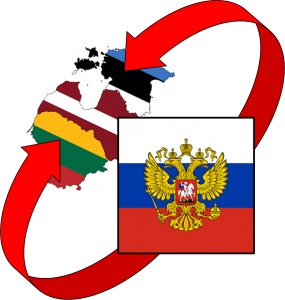 The Latvians knew the Russians would be back. They knew that their independence was a precious, fragile thing, and that their eastern neighbor would not let them keep it.
The Latvians knew the Russians would be back. They knew that their independence was a precious, fragile thing, and that their eastern neighbor would not let them keep it.
What they didn’t know is how Russia’s Baltic ambitions would end not with a battle, but with a website.
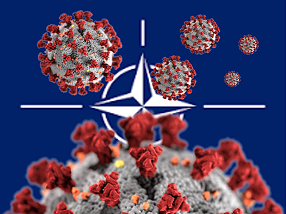 In the fall of 2020, the stage was set. NATO allies were wrapped up in their response to the novel coronavirus pandemic. National budgets shifted away from military spending. And the United States, NATO’s most powerful ally, was consumed by election-year politics.
In the fall of 2020, the stage was set. NATO allies were wrapped up in their response to the novel coronavirus pandemic. National budgets shifted away from military spending. And the United States, NATO’s most powerful ally, was consumed by election-year politics.
The Baltic republics had weathered the coronavirus relatively well – so it was surprising when cries erupted in Latvian social media accusing the government of allowing coronavirus to break out in the country’s ethnically Russian eastern regions. Protests grew in the eastern urban center of Daugavpils.
 Latvian intelligence concluded that the crisis was manufactured by Russian information warfare units, who had extensive experience in using social media to orchestrate mass anger. The protests grew violent, and demonstrators stormed the city hall in Daugavpils. Urged on by embedded Russian advisors, the protesters forced an armed confrontation. Images of body bags flooded the news.
Latvian intelligence concluded that the crisis was manufactured by Russian information warfare units, who had extensive experience in using social media to orchestrate mass anger. The protests grew violent, and demonstrators stormed the city hall in Daugavpils. Urged on by embedded Russian advisors, the protesters forced an armed confrontation. Images of body bags flooded the news.
A ginned-up social media storm had become a geopolitical crisis. Images of the showdown at Daugavpils flew through Europe on the wings of conspiracy theories: Latvia has requested NATO assistance to crush the uprising. NATO forces are on their way to Latgale with orders to shoot on sight. NATO’s leaders were facing paralyzing internal pressure.
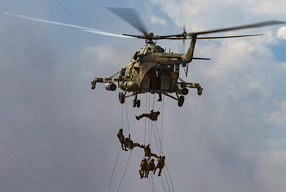
When it happened, it happened too quickly for anybody to react. On a chilly October night, Russian troops seized Riga with a helicopter assault. In eastern Latvia, Russian mechanized infantry formed a “protective cordon” around Latgale. The Russian president announced plans for a custodian government until a new government could be formed.
Amid the geopolitical drama, Latvians were suffering from a lack of essential services. Pro-Russian militias became increasingly aggressive in stifling dissent. When Latvians turned to social media to organize demonstrations, internet service in Latvia disappeared – as did the organizers.

Unknown to the occupiers, the tides were already turning against them. Teams of covert cameramen – Latvian guardsmen equipped and trained by U.S. Special Forces – were documenting the occupation’s brutality. The Green Berets sent the imagery to Special Operations Command-Europe via secured satellite communications.
Back in Stuttgart, teams of Psychological Operations soldiers worked with Latvians on loan from NATO to create a website called Latvia Is Burning. Like its namesake, Raqqa Is Burning – a virtual exposé of the Islamic State’s brutality – this website published raw and searing vignettes of life inside occupied Latvia.
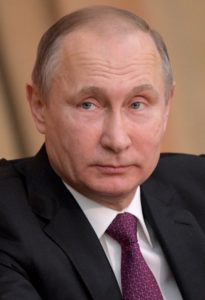
The power of Latvia Is Burning was undeniable; its voices demanded justice. Responding to mounting public pressure, politicians called for Russian forces to leave Latvia and yield to a US-led multinational security force.
Faced with a sudden surplus of international resolve, the Russian president decided his desire for a puppet-led Baltic client state wasn’t worth the devastation of peer-to-peer conventional conflict. Russian forces withdrew. An information operation ended the war before it could even begin.
Our First Runner Up was “I-Day: Information Warfare in 2035,” by Tony Stark.
Imagine a world in which patriots are twisted into unwitting enemy sleeper cells. A world in which civilians become precision weapons with a psychological trigger. A future dominated by an automated revolution in predictive analytics, hyperpartisanship, and augmented reality is just around the corner.

In 2014, Little Green Men appeared in Crimea with thin claims of no association with the Russian government. In 2035, those Little Green Men will wear American uniforms to sell the narrative of an enemy information operation. Deception is the bedrock of warfare, but the technology that will make such convincing operations possible on a global scale is only a few years away.
Information operations are only as good as the story they try to sell. As the digital world leaps off our screens and begins to merge with the physical world through the development of augmented reality, deep fakes, and ever smarter AI, reality will become as malleable as the science fiction stories through which these concepts were born.
In 2035, a complex, years-long Joint information operation between Russia and China climaxes on ‘I-Day,’ the start of their war with the United States. As Russian and Chinese troops seize key outposts in the Pacific, the US is paralyzed at all levels by a coup in Washington. Except, there is no coup. Uncertainty and 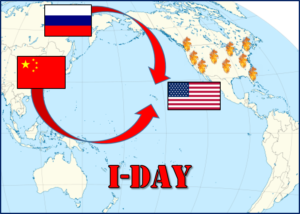 paranoia driven by misinformation leads to hesitation and poor decision-making while real-world assassination attempts on US leadership by American citizens radicalized by targeted information operations are underway. Critical infrastructure hardened from cyberattack are catastrophically damaged by lone wolves and militias whose radicalism has been bred and hijacked by foreign intelligence agencies. In 2020, this might seem like an operation that would require massive amounts of manpower, but the use of artificially intelligent operations managers built upon today’s chatbots and analytics systems will become a force multiplier in future information operations. In 2035, the resources required to maintain these manipulative systems will be a fraction of what today’s information operations by the likes of the GRU and MSS require for mission success. In 2035, people are America’s weakness.
paranoia driven by misinformation leads to hesitation and poor decision-making while real-world assassination attempts on US leadership by American citizens radicalized by targeted information operations are underway. Critical infrastructure hardened from cyberattack are catastrophically damaged by lone wolves and militias whose radicalism has been bred and hijacked by foreign intelligence agencies. In 2020, this might seem like an operation that would require massive amounts of manpower, but the use of artificially intelligent operations managers built upon today’s chatbots and analytics systems will become a force multiplier in future information operations. In 2035, the resources required to maintain these manipulative systems will be a fraction of what today’s information operations by the likes of the GRU and MSS require for mission success. In 2035, people are America’s weakness.

The “coup” is broadcast across media feeds of all Americans as code injected by human operatives into Silicon Valley’s applications sells the narrative with deep fakes, foreign SOF posing as American soldiers, and confirmation through prewritten news articles published on multinational media platforms. For full effect, Russian and Chinese Info-bots targeted millions of ordinary Americans as the coup narrative played out. The bots leaked secrets and spread lies that brought neighbors to each other’s throats as the country burned. The American decision-making process is frozen in uncertainty, and in an age when battlefield decisions require lightspeed reactions, it costs the US dearly. By the end of the I-Day, the Hawaiian and Aleutian Islands, as well as other key US territories in the Pacific, are seized as the US tears itself apart. Eventually the Americans will retake the narrative, but not without trust in the chain of command and government permanently damaged by the devastation of I-Day.
The Winner of the Mad Scientist Information Warfare Vignettes Writing Contest was “Catch a Fish,” by Davis Ellison.

The Westerners were the easiest. So quick to believe. Shen opened his messages on r/FreeSiberia, not surprised to find yet another set of French, Norwegian, and American youngsters willing to die for the cause of some land they had never even heard of six months before. r/FreeSiberia was only one of several sub-reddits Shen had created over the last year, the others being in other languages and focusing on other breakaway regions of Russia.
Each of the pages were his babies. He had birthed them, raised them, and continued to shape them entirely on his own. These pages were subtle enough to avoid notice, the Westerners never even looked. Their focus on the famed Unit 61398 and the PLA Strategic Support Force blinded them that a young lieutenant 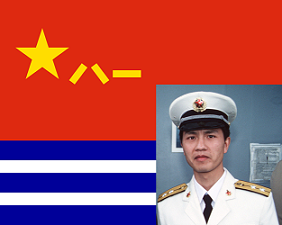 like him, Yang Shen, a junior officer of the PLA Naval Air Forces stationed with the Northern Fleet in Qingdao would have some role to play. Hell, Reddit had gone unnoticed by most of the Western analysts and “researchers” who were so focused on their own Twitter and Facebook accounts that they couldn’t see that well over half of their young people connected through Reddit. Those analysts probably thought “Ivan” was still trying to throw elections through fake Facebook groups. Shen knew better.
like him, Yang Shen, a junior officer of the PLA Naval Air Forces stationed with the Northern Fleet in Qingdao would have some role to play. Hell, Reddit had gone unnoticed by most of the Western analysts and “researchers” who were so focused on their own Twitter and Facebook accounts that they couldn’t see that well over half of their young people connected through Reddit. Those analysts probably thought “Ivan” was still trying to throw elections through fake Facebook groups. Shen knew better.
The Russians made it even easier. When the National Guards shot the ‘monstration’ protestors in Novosibirsk, it didn’t exactly make it a hard job to build up sympathy online. Sympathy was the first step on a long journey for many of the fighters. The biggest surge came after the video of that young artist being shot in the head by a sniper. Nasty business. Perfect for Shen.
The trick was to post multiple times a day, every day. The easiest part is Shen  needed no approval from his superiors about what he posted. Chaos was the goal, and chaos is what he delivered. Some old colonel had used some axiom from thousands of years ago to describe what Shen did: “disturb the water and catch a fish.” He had no use for aphorisms that made the elderly feel warm and spooked the West. Shen only wanted results.
needed no approval from his superiors about what he posted. Chaos was the goal, and chaos is what he delivered. Some old colonel had used some axiom from thousands of years ago to describe what Shen did: “disturb the water and catch a fish.” He had no use for aphorisms that made the elderly feel warm and spooked the West. Shen only wanted results.
u/GroovyLucy had clearly taken the next step.
“hey aldar [Some old Siberian name Shen had found on a quick Google search], we are all set, it is finally time, Free Siberia!”
Shen had provided the young man’s group a set of old, but reliable, Type-81 rifles that the PLA usually only used for militias in rural backwaters. And u/GroovyLucy was just part of one group in Novosibirsk, among other cities.
The uproar would be massive, new “shots heard round the world,” especially when the Russian forces cracked down hard. It would be big. Messy.
Distracting.
Distracting enough for the “scientific teams”  on Severnaya Zemlya to deploy their shipping container air-defense systems, and for the patriots of the Maritime Militia to achieve their missions across the Kamchatka Peninsula.
on Severnaya Zemlya to deploy their shipping container air-defense systems, and for the patriots of the Maritime Militia to achieve their missions across the Kamchatka Peninsula.
China as a ‘Near-Arctic’ power. “Quaint,” Shen thought.
If you enjoyed today’s post, check out Weaponized Information: One Possible Vignette
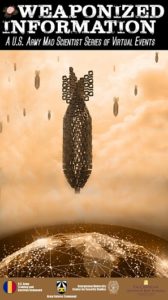 Our winner, Davis Ellison, will present his vignette during our Weaponized Information Virtual Conference tomorrow, Tuesday, 21 July 2020. The agenda for this event can be viewed here. In order to participate in this virtual conference, register here [via a non-DoD network].
Our winner, Davis Ellison, will present his vignette during our Weaponized Information Virtual Conference tomorrow, Tuesday, 21 July 2020. The agenda for this event can be viewed here. In order to participate in this virtual conference, register here [via a non-DoD network].
>>> REMINDER: If you missed participating in any of the previous webinars in our Mad Scientist Weaponized Information Virtual Events series — no worries! You can watch them again here [via a non-DoD network] and explore all of the associated content (presenter biographies, slide decks, scenarios, and notes from each of the presentations) here.
About our vignette authors:
Rob Kunzig is a military communications professional based in Stuttgart, Germany. He lived in Riga, Latvia for three years. He is a Lieutenant in the US Navy Reserve.
Tony Stark is a US-China policy blogger and science fiction writer currently transitioning from the Army to graduate school at Georgetown University. The vignette here describes the first act of his forthcoming novel, Ex Supra (October 2020). From the first combat jump into Mars to trench warfare in the Himalayas, Ex Supra blurs the line between bleeding edge technology and the bloody reality of combat in 2035. You can find Tony’s other work at Small Wars Journal, the Atlantic Council’s Art of the Future, The Company Leader, and BreakingBeijing.com (which he runs). You can also follow him on Twitter @natsecelitist.
Davis Ellison graduated with a master’s in political science from the University of North Carolina at Chapel Hill, where he both studied and worked in Germany and the United Kingdom. He has experience working in international organizations, think tanks, academia, and developing concepts for warfare development. He is currently an employee of NATO Allied Command Transformation.
Disclaimer: The views expressed in this blog post are solely those of the authors and do not necessarily reflect those of the Department of Defense, Department of the Army, Army Futures Command, or the Training and Doctrine Command.




I anticipate China will be racked by multiple more sophisticated, viruses, with far higher morbidity, mortality, and Ro factors by 2035. The advent of AI swarms of internet, drone, and nanotech military applications will become exponentially more advanced.
The new great silk road indicates China is playing a long game, but the logistics of running amok seem impracticable.